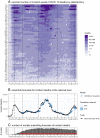Evaluation of individual and ensemble probabilistic forecasts of COVID-19 mortality in the United States
- PMID: 35394862
- PMCID: PMC9169655
- DOI: 10.1073/pnas.2113561119
Evaluation of individual and ensemble probabilistic forecasts of COVID-19 mortality in the United States
Erratum in
-
Correction for Cramer et al., Evaluation of individual and ensemble probabilistic forecasts of COVID-19 mortality in the United States.Proc Natl Acad Sci U S A. 2023 Apr 11;120(15):e2304076120. doi: 10.1073/pnas.2304076120. Epub 2023 Apr 4. Proc Natl Acad Sci U S A. 2023. PMID: 37014868 Free PMC article. No abstract available.
Abstract
Short-term probabilistic forecasts of the trajectory of the COVID-19 pandemic in the United States have served as a visible and important communication channel between the scientific modeling community and both the general public and decision-makers. Forecasting models provide specific, quantitative, and evaluable predictions that inform short-term decisions such as healthcare staffing needs, school closures, and allocation of medical supplies. Starting in April 2020, the US COVID-19 Forecast Hub (https://covid19forecasthub.org/) collected, disseminated, and synthesized tens of millions of specific predictions from more than 90 different academic, industry, and independent research groups. A multimodel ensemble forecast that combined predictions from dozens of groups every week provided the most consistently accurate probabilistic forecasts of incident deaths due to COVID-19 at the state and national level from April 2020 through October 2021. The performance of 27 individual models that submitted complete forecasts of COVID-19 deaths consistently throughout this year showed high variability in forecast skill across time, geospatial units, and forecast horizons. Two-thirds of the models evaluated showed better accuracy than a naïve baseline model. Forecast accuracy degraded as models made predictions further into the future, with probabilistic error at a 20-wk horizon three to five times larger than when predicting at a 1-wk horizon. This project underscores the role that collaboration and active coordination between governmental public-health agencies, academic modeling teams, and industry partners can play in developing modern modeling capabilities to support local, state, and federal response to outbreaks.
Keywords: COVID-19; ensemble forecast; forecasting; model evaluation.
Conflict of interest statement
Competing interest statement: A.V., M.C., and A.P.P. report grants from Metabiota Inc. outside the submitted work.
Figures





References
-
- Davies S. E., Youde J. R., The Politics of Surveillance and Response to Disease Outbreaks: The New Frontier for States and Non-state Actors (Routledge, 2016).
-
- Cramer E., et al. , COVID-19 Forecast Hub: 4 December 2020 snapshot. https://zenodo.org/record/4305938#.Yf1TQOrMI2x (Accessed 11 December 2020).
-
- CDC, COVID-19 Forecasting and Mathematical Modeling. Centers for Disease Control and Prevention. https://www.cdc.gov/coronavirus/2019-ncov/science/forecasting/mathematic... (Accessed 2 March 2022).

